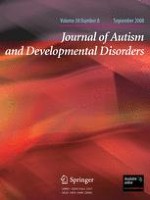01-09-2008 | Original Paper
Obstetric and Parental Psychiatric Variables as Potential Predictors of Autism Severity
Gepubliceerd in: Journal of Autism and Developmental Disorders | Uitgave 8/2008
Log in om toegang te krijgenAbstract
Associations between obstetric and parental psychiatric variables and subjects’ Autism Diagnostic Interview-Revised (ADI-R) and Autism Diagnostic Observation Schedule (ADOS) domain scores were examined using linear mixed effects models. Data for the 228 families studied were provided by the Autism Genetic Resource Exchange. Hypertension (P = 0.002), preeclampsia (P = 0.021) and generalized edema (P = 0.011) were associated with higher ADI-R communication scores. Hypertension (P = 0.011), albuminuria (P = 0.039) and generalized edema (P = 0.009) were associated with higher ADI-R repetitive behaviors scores. Parent depression was associated with higher ADI-R repetitive behaviors scores (P = 0.005), and parent anxiety with lower ADOS social/communication composite scores (P = 0.025). The associations between hypertension-related obstetric conditions and autistic severity warrant further investigation and raise intriguing questions regarding potential causal and modifying factors in autism.
